Nvidia Announces New Drive Platforms With Orin and Ampere
by Andrei Frumusanu on May 14, 2020 6:01 AM EST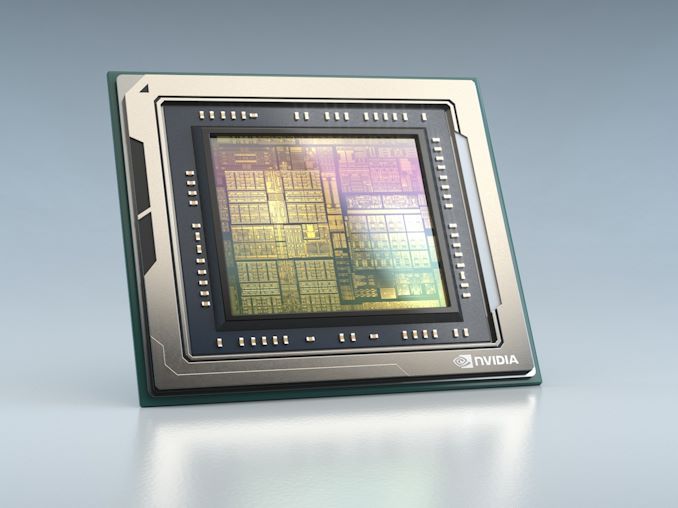
Nvidia’s Orin SoC chipset had been on Nvidia’s roadmaps for over 2 years now, and last December we got the first new details of the new automotive oriented silicon chip, revealing characteristics such as it containing 12 core cores of Arm’s newest “Hercules” microarchitecture (A77 successor).
Orin is meant to be the heart of Nvidia’s upcoming DRIVE automotive platforms, and today the company is ready to reveal a few more important details such as the scalability of the SoC and the different DRIVE solutions.
| NVIDIA ARM SoC Specification Comparison | |||||
| Orin | Xavier | Parker | |||
| CPU Cores | 12x Arm "Hercules" | 8x NVIDIA Custom ARM "Carmel" | 2x NVIDIA Denver + 4x Arm Cortex-A57 |
||
| GPU Cores | Ampere iGPU (?? cores) |
Xavier Volta iGPU (512 CUDA Cores) |
Parker Pascal iGPU (256 CUDA Cores) |
||
| INT8 DL TOPS | 200 TOPS | 30 TOPS | N/A | ||
| FP32 TFLOPS | ? | 1.3 TFLOPs | 0.7 TFLOPs | ||
| Manufacturing Process | 7nm? | TSMC 12nm FFN | TSMC 16nm FinFET | ||
| TDP | ~5-45W | 30W | 15W | ||
Specifications wise, the newest revelations about the Orin design is that it features Nvidia’s newest Ampere architecture as its integrated GPU. Generally, this shouldn’t come as too much of a surprise given the timeline of the SoC.
Nvidia still doesn’t disclose exact configurations of the GPU, but if the mock-up die-shot of the chip is anything to go by, we’ll be seeing a 32SM configuration – which fits nicely with the claimed peak 200 INT8 DL TOPs that Nvidia claims for the chip.
Manufacturing wise, we again don’t have exact details, but we’re assuming a 7nm-class process node. One interesting disclosure today however was the fact that Orin is supposed to scale from 5W to up to 45W platforms, which is a very wide range.
The 5W platforms claims up to TOPs inference performance, and it’s meant for ADAS solutions as depicted above, designed to fit behind a windshield. Nvidia being able to scale Orin down to a 5W TDP is extremely interesting, but undoubtedly will have the chip disable much of its capabilities, or clock down to very low frequencies to achieve this power envelope.
The chip is also offered in an L2+ automotive solution, enabling the full power of Orin at up to 45W. Here we see the full 200TOPs of inference performance that Nvidia had disclosed back in November. We're seeing 8 DRAM chips on the depicted board, likely pointing out to a 128-bit memory controller setup.
Finally, Nvidia is bringing out the biggest guns in its DRIVE line-up for the robotaxi solution, an L5 automotive solution is meant to power fully autonomous robotaxi vehicles.
The platform here has two Orin SoCs paired with two Ampere GPUs for total power envelope of 800W and up to 2000 TOPs of performance. The GPU here, judging by its size and form-factor with HBM memory is seemingly the newest GA100 Ampere GPU. Nvidia disclosed that this GPU alone scales up to 400W in the SXM form-factor. Clocking two of these slightly lower and adding two 45W Orin SoCs gets us to the massive 800W power envelope.



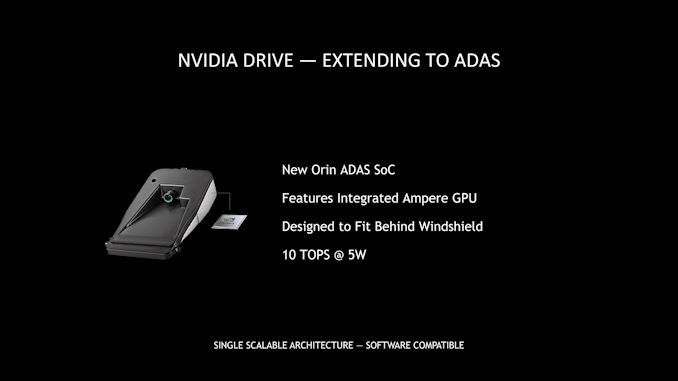
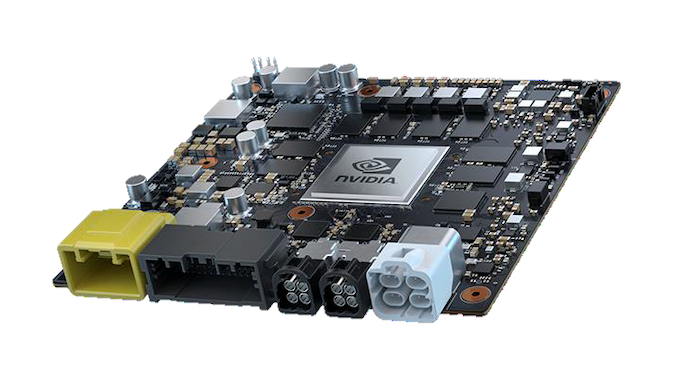
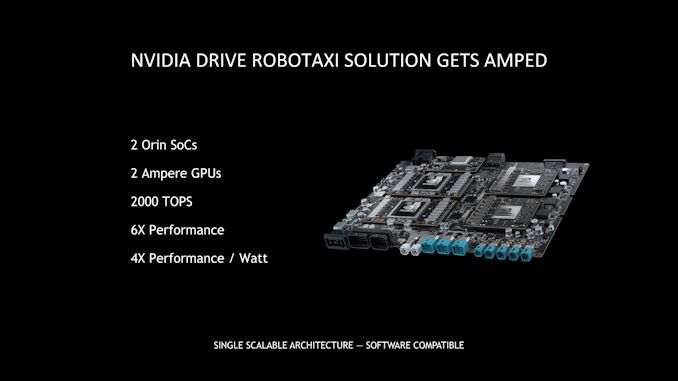
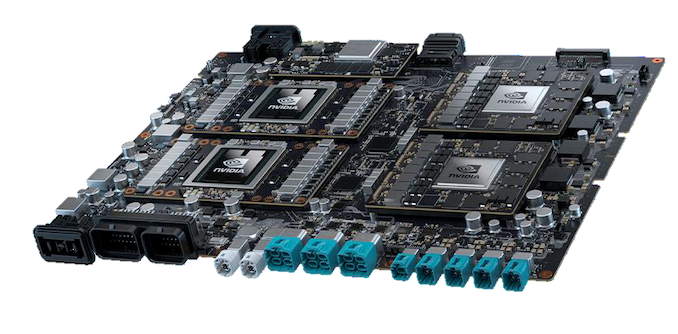








32 Comments
View All Comments
Sivar - Thursday, May 14, 2020 - link
How does Orin compare with Tesla's hardware 3.0 FSD chip?brucethemoose - Thursday, May 14, 2020 - link
Orin has more transistors, at the very least.cyrusfox - Thursday, May 14, 2020 - link
Do they have any partners using this for Autonomous driving? Is tesla or Mobileye going to be customers? Or is Nvidia doing their own independent Autonomous driving push I haven't heard about?cyrusfox - Thursday, May 14, 2020 - link
Looks like I am mighty ignorant, looks like they may have the lionshare of the market https://www.nvidia.com/en-us/self-driving-cars/par...Yojimbo - Thursday, May 14, 2020 - link
Mobileye is a competitor, not a customer. Tesla plans on using their own. And as you noted, most of the rest of the industry is using NVIDIA's chips for development, although not that many have actually brought anything to production, yet. Instead, they are using Mobileye ADAS. That's probably why NVIDIA is bringing Orin down to 5W. Self-driving cars look like they will take a lot longer than people hoped for 5 years back, so NVIDIA is trying to get the car companies to use NVIDIA chips for ADAS while they develop autonomy algorithms. That could be a cost-savings if they can create a smooth transition from one to the other, rather than developing two completely different systems, one for ADAS using Mobileye and one for self-driving using NVIDIA. I think Mobileye are converging their ADAS and autonomy so that would give them a leg-up in the competition to attract development efforts in autonomy if NVIDIA doesn't also offer competitive ADAS solution that can converge with their autonomy solutions.Santoval - Sunday, May 17, 2020 - link
The two GA100 Ampere GPUs in the last image appear to have 4 stacks of HBM2 rather than 6. So Nvidia also shaved power (and money) by removing 4 HBM dies beside downclocking the GPUs a bit. In any case, can they actually do -assuming there is a practical way to supply the beast with 800W of power in a *car*- L5 self-driving?Have they tested that or did they just model it - or, even worse, just calculated that "this is the computing power required for L5 self-driving"? I would assume it's one of the latter two, since I don't think even the most advanced test / prototype cars have the sensors and other required peripheral features for L5 self-driving. Maybe L4 tops.
Models and calculations never tell the full picture, and that must particularly be the case for self-driving, which has a myriad of variables and surprises. Until something claiming to support "ability X" is tested we cannot know it actually supports it, therefore the claim is baseless.
CiccioB - Thursday, May 21, 2020 - link
What's the problem with 800W power consumption?Do you know what's the power consumption of an air conditioner on the car?
BTW it's 800W as maximum consumption. I do not think that it is going 100% of the computing capacity for 100% of the time.
It seems Nvidia is using the defective GA100 GPUs in these solutions. It is good for them to have more markets beside the gaming one where they can sell different cuts of their products in order to gain as much as possible.
phoenix_rizzen - Monday, May 25, 2020 - link
The article and chart list 200 TOPS multiple times, but each of the Nvidia graphics show 2000 TOPS.Which is it? 200 or 2000 TOPS?
cyrand - Tuesday, May 26, 2020 - link
One Orin Chip is 200 TOPS. The Drive for RoboTaxi has 2 Orin chips and 2 discrete Ampere GPUs which give is 2000 TOPS.